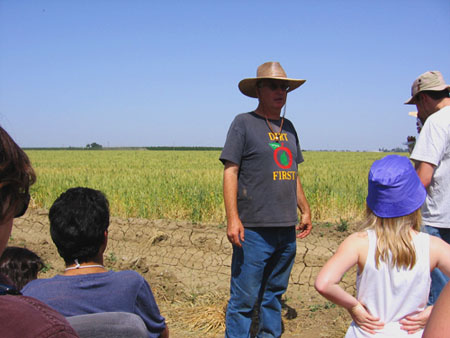I didn’t want to celebrate the 4th of July. I’m having very ambivalent feelings in the patriotism department, and, since the car accident, I just haven’t felt much like celebrating. But the day took on a life of its own, unrelated to any sort of officially declared bank and postal holiday. Duck and I were joined by Farmer B and another friend and we had a sparkly wonderful day that flowed from Indian-buffet brunch at our beloved “all fresh! never frozen!” vegetarian Indian restaurant down the street to playing our favorite board game, Settlers, in the backyard of our favorite local coffeeshop.
Then home to our newly set-up art room where Duck worked on his graphic novel and the rest of us made buttons and collages while the pets ran about, and then our visiting friends and I made a fresh-from-the-box meal while Duck worked furiously to complete his project and we all had this gorgeous dinner by candelight and then Duck washed all the dishes and we had coffee and dessert and played two more games of Settlers. We ended our glorious day by sitting together on the couch in our pajamas while Duck gave us the first look at his newly finished piece.
This was truly a celebration. Ever since the accident, I’ve been flipping back and forth between “Oh man, this is really, really an awful thing to have happened” and “Thank all that is holy that everyone is okay.” But mostly I’ve been floating through space, able to connect with how heartbreaking and terrifying it would have been if something worse had happened, but predominantly squashed by the weight of all that did happen and all that is still to come. So it was a gift to have this day, this seamless day of friends and games and art and food, where one moment flowed perfectly into the next and, as cheesy as it sounds, I got to really remember in my body why life is so precious.
And of course it wouldn’t be a celebration if it didn’t involve food – lots of it and only the good stuff, please! Our menu was drawn directly from the bounty of my box: Warm arugula with tempeh bacon and garlic over soft, creamy polenta made with scrap stock (batch IV), and chard with toasted walnuts made following Duck’s mom’s recipe. Farmer B found a bottle of wine someone had brought to a party years ago, way up on a shelf in my pantry, and we had this surprisingly good wine, and ginger beer for the non-drinkers. And while we ate dinner, dessert was baking in the oven. We would be having plum and strawberry clafouti, my first clafouti of the summer, which is for me a celebration all by itself.
Clafouti (or clafoutis) is a French dessert that is sort of like a firm fruit custard. Although traditionally made with cherries, the term clafouti is now used to describe this dessert when made with any kind of fruit. I made my first clafouti (a cherry one) in high school to accompany a French class report on the regions of France. In summers past I have made one after another all summer long, using surplus plums from friends’ trees, nectarine bounty from the farmer’s market – whatever stone fruit or berry comes my way. This is my second most frequently requested recipe (someday I’ll tell you about my ginger chocolate torte…) and now that we are getting all kinds of cherries and berries and lovely stone fruits in our boxes, I wanted to pass the recipe along to you.
French Summer Fruit Clafouti (adapted from epicurious.com)
This is one of the easiest dessert recipes I’ve ever encountered, and to make it even easier I’ve converted it to a “one-pot” style recipe. As long as you keep a bottle of Riesling or other sweet wine on hand you’ll be able to whip this up with whatever fruit you have. (Last summer I didn’t end up using all of the $5 bottle of Moscato I got from Trader Joe’s for making clafouti, but it still tasted perfectly good when I used it last night, a YEAR later, after sitting, re-corked, on top of my fridge!)
4-5 ripe nectarines (or the equivalent in weight of plums, peaches, berries, cherries or any combination thereof)
1 C. Riesling or other sweet, fruity wine
5 T. butter
4 eggs
1/2 C. sugar
1/8 t. salt
1/2 C. flour (to make a gluten-free version, use half a cup of whatever GF flour combo or mix you would usually use for pancakes)
1 C. milk/hemp milk/rice milk/soy milk
1 T. vanilla
Preheat oven to 325 degrees. Butter a 2-quart baking dish.
Cut fruit into 1/4-inch wedges (or pit and halve cherries) and macerate in a bowl with the wine for 15 minutes. Leave peels on fruit – they add to a colorful presentation.
Melt butter in a medium-sized pot over low heat. Remove from heat and cool slightly, then whisk in eggs, sugar, salt. Whisk in flour until combined well. Whisk in, until smooth, milk, vanilla, and 1/4 C. wine from the fruit mix.
Transfer fruit to bottom of baking dish using a slotted spoon. Pour batter over fruit (fruit will float to top). (The rest of the wine the fruit soaked in can now be used for sangria or just sipped straightaway!)
Bake in upper third of the oven until puffed and set in the center, 55-60 minutes. Transfer clafouti to a rack to cool. Serve warm or at room temperature. Leftovers make a decadent but still vaguely “healthy” breakfast – hey, it’s fruit and eggs, right?













